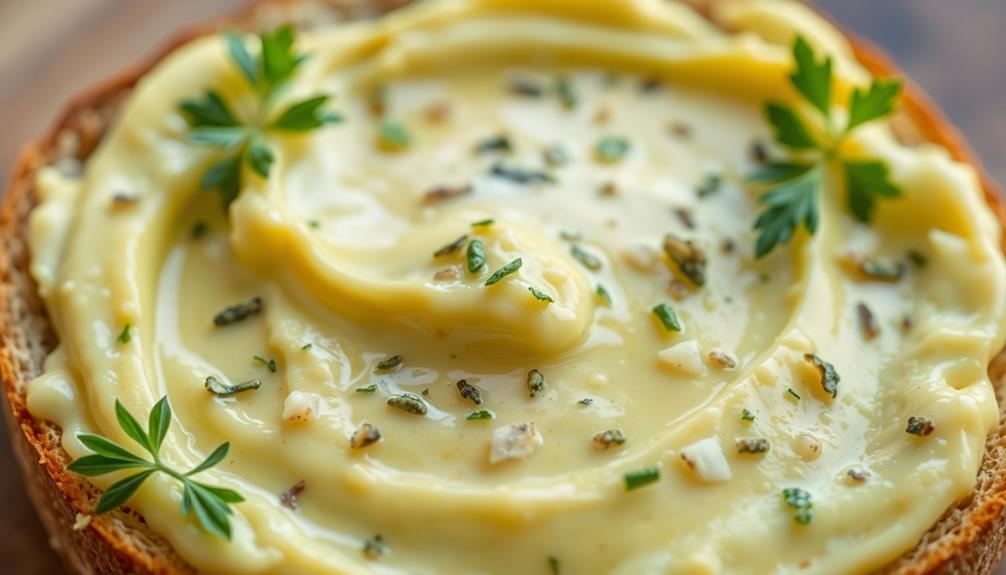Beurre Meunière is a classic French sauce that transforms ordinary fish into a refined and delectable dish. This nutty browned butter sauce blends rich, caramelized butter with zesty lemon and fragrant parsley, elevating even the simplest seafood preparations. The term "Meunière" translates to "miller's wife," reflecting its rustic peasant cooking origins. Today, this beloved sauce is celebrated for its versatility, pairing beautifully with delicate white fish, heartier varieties like salmon, and even roasted vegetables. With its ease of preparation and impressive flavor, Beurre Meunière is a true gem in the culinary world – and there's more to discover about this timeless classic.
Key Takeaways
- Beurre Meunière is a classic French sauce that originated from traditional peasant cooking, utilizing browned butter to enhance the flavor of fish.
- The term "Meunière" translates to "miller's wife," reflecting the sauce's rustic preparation and its evolution into a beloved pairing for delicate white fish.
- The sauce is easy to prepare at home, requiring simple ingredients like unsalted butter, lemon juice, and parsley, making it suitable for home cooks of all skill levels.
- Beurre Meunière adds a rich, nutty flavor and velvety texture that complements various fish dishes, elevating the overall dining experience.
- The sauce can be versatile, as it can be drizzled over fish, roasted vegetables, mashed potatoes, and even paired with crusty bread for a complete dining experience.
History

Though the precise origins of the Beurre Meunière sauce are uncertain, it's believed to have emerged from the traditional cooking techniques of French peasants. These hardworking folks would often use the leftover browned butter from cooking fish or meat to create a simple, yet flavorful sauce.
The term "Meunière" refers to the miller's wife, who'd likely have been the one preparing this rustic dish in the old days.
Over time, as French cuisine evolved, the Beurre Meunière sauce became a beloved classic, often served alongside delicate white fish like sole or trout.
The nuttiness of the browned butter, combined with the bright acidity of lemon and the gentle herbal notes, creates a harmonious balance that enhances the natural flavors of the seafood.
Today, this sauce is cherished by chefs and home cooks alike, as it offers a delightful way to elevate even the most humble of fish dishes.
Recipe

Beurre Meunière Sauce is a classic French sauce that pairs beautifully with fish. This simple yet elegant sauce adds a rich, nutty flavor to any seafood dish. The key to its success lies in the proper technique of browning the butter to achieve a nutty aroma and flavor.
Preparing the Beurre Meunière Sauce requires just a few ingredients and minimal effort, making it an excellent choice for a quick and delicious meal. The sauce's versatility allows it to complement a variety of fish, from delicate white fish to heartier varieties like salmon or tuna.
Ingredients:
- 4 tablespoons unsalted butter
- 2 tablespoons freshly squeezed lemon juice
- 2 tablespoons chopped fresh parsley
- Salt and black pepper to taste
In a small saucepan, melt the butter over medium heat, swirling the pan occasionally, until the butter turns a nutty brown color, about 5 to 7 minutes. Be careful not to let the butter burn.
Remove the pan from the heat and stir in the lemon juice and parsley. Season with salt and pepper to taste.
When serving the Beurre Meunière Sauce, it's important to drizzle it over the fish immediately, as the sauce can quickly cool and lose its velvety texture. The sauce pairs exceptionally well with a variety of fish, including sole, halibut, or trout.
For a truly indulgent experience, consider serving the fish with a side of roasted vegetables or a simple salad.
Cooking Steps
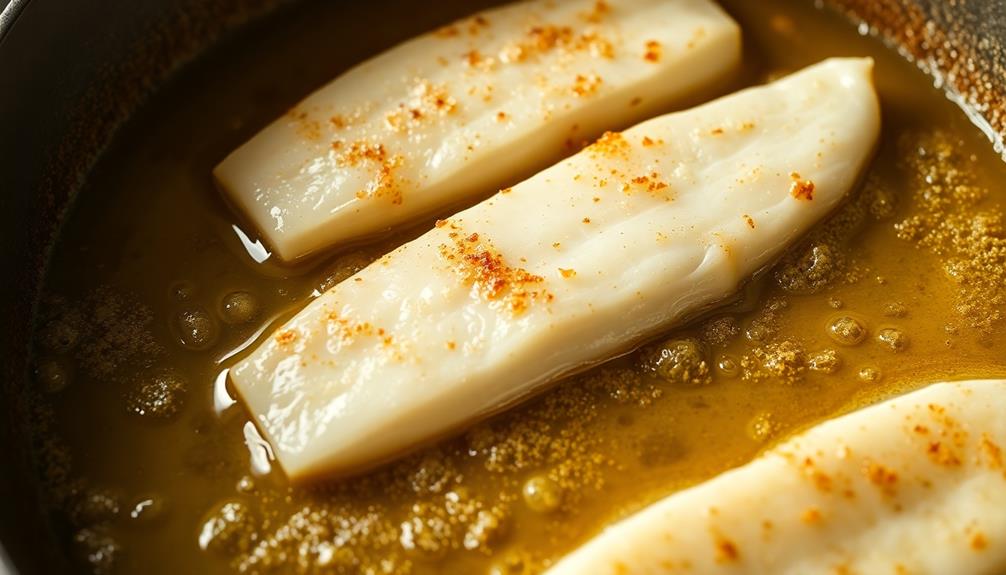
Melt the butter in a skillet over medium heat until it starts to brown and gives off a nutty aroma.
The culinary uses of butter provide a rich and creamy flavor that enhances your dish.
Squeeze in some fresh lemon juice and sprinkle in chopped parsley for a zesty, herbal finish.
Spoon the fragrant, browned butter over your fish, then season it with a pinch of salt and pepper to taste.
Step 1. Melt Butter in a Skillet
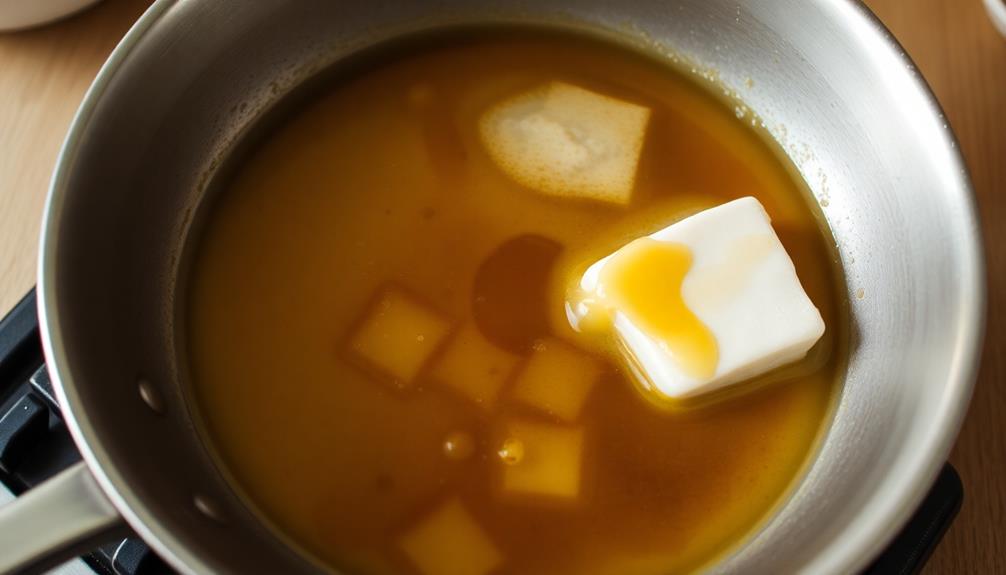
In a skillet, melt the butter over medium heat. You'll want to keep a close eye on it, stirring occasionally, until the butter sizzles and foams up.
As it melts, the milk solids will start to brown, creating a nutty, aromatic aroma. This browned butter, or beurre noisette, is the foundation of the classic French beurre meunière sauce.
Gently swirling the pan helps the butter brown evenly. You'll know it's ready when the butter turns a rich, golden-brown color and the milk solids have formed delicate, toasted bits at the bottom of the skillet.
Be careful not to let the butter burn, as that will create a bitter, acrid flavor. The whole process should take 2-3 minutes, so stay focused and keep that butter moving.
Once the butter is perfectly browned, it's time to take it off the heat and get ready for the next step in creating this simple, yet flavor-packed sauce.
Step 2. Cook Until Butter Browns
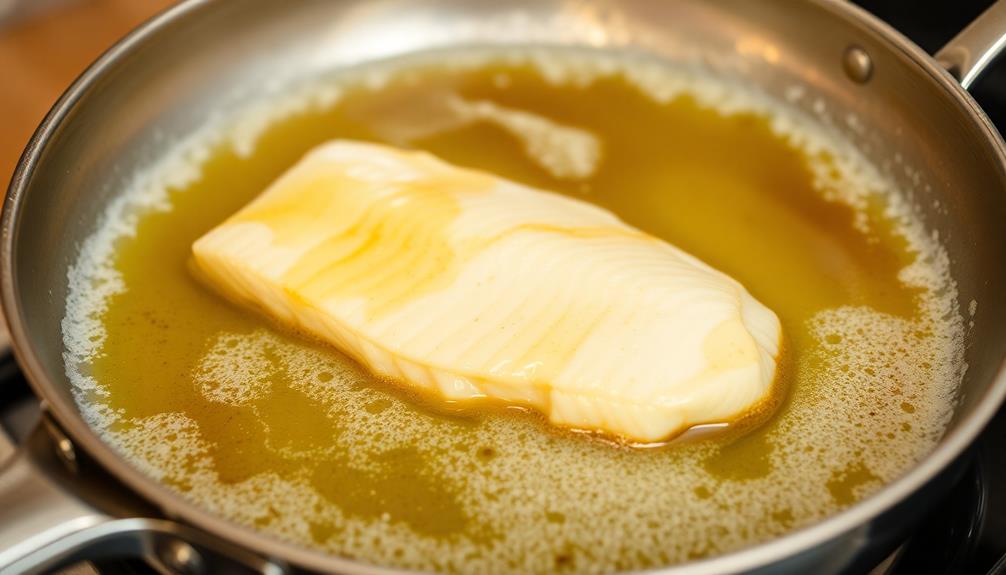
Once the butter is melted, you'll want to keep a close eye on it, stirring occasionally, until the butter sizzles and foams up.
As the butter heats, you'll notice it start to turn a light golden color. This is when the real magic happens!
Continue cooking, stirring frequently, and watch as the butter transforms into a rich, nutty-brown hue. The aroma will become absolutely heavenly – nutty, buttery, and incredibly inviting.
Don't let it go too far, though. You want the butter to be a deep, toasty brown, not burned.
Once it reaches that perfect shade, remove the skillet from the heat right away. The carryover cooking will continue to deepen the color and flavor of the beurre meunière sauce.
With just a few minutes of attentive cooking, you'll have created a sauce that's truly fit for a fine dining experience. Drizzle it over your fresh fish and enjoy the delightful results.
Step 3. Add Lemon Juice and Parsley

With the perfectly browned beurre meunière sauce ready, it's time to add a few more flavors. Grab a fresh lemon and give it a good roll on the counter to help release the juices. Carefully slice it in half and squeeze the tart, golden liquid into the pan, watching as it sizzles and combines with the nutty butter.
Don't be shy – you want enough lemon to brighten the sauce and balance the richness.
Next, roughly chop a handful of fresh parsley leaves, their vibrant green hue a beautiful contrast to the amber-colored sauce. Toss the fragrant parsley into the pan, stirring gently to incorporate. The herbal notes will add a lovely freshness, complementing the fish you're about to serve.
Take a moment to inhale the captivating aroma – the lemon's zing, the butter's toasted nuance, and the parsley's verdant perfume all mingle together in perfect harmony.
This is the essence of beurre meunière, ready to drizzle over your perfectly cooked fish for a sublime dining experience.
Step 4. Spoon Browned Butter Over Fish
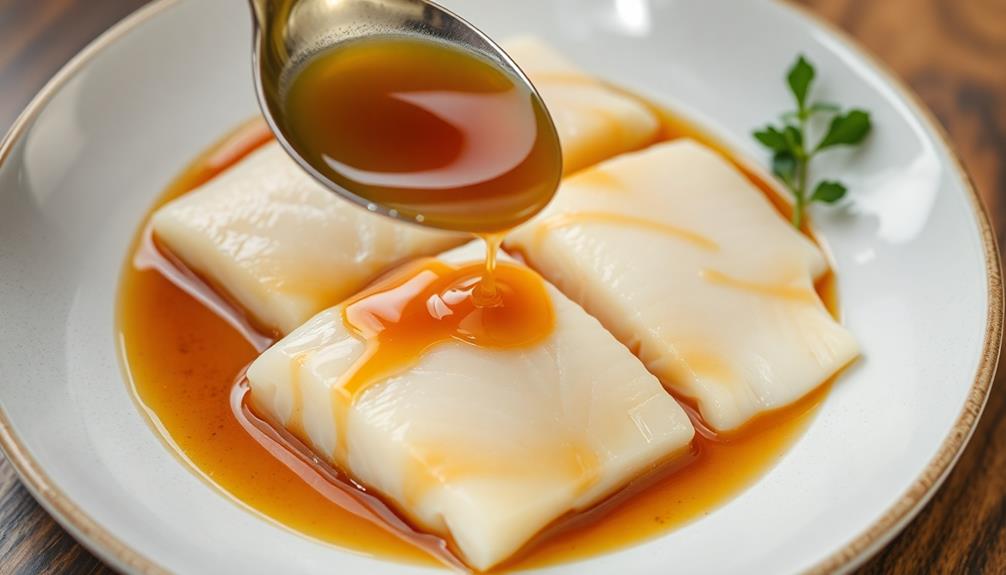
Gently spoon the browned beurre meunière sauce over the cooked fish. The rich, nutty aroma will fill the air, enticing your senses.
Watch as the golden-brown butter cascades over the delicate fillets, creating a visually stunning contrast. The sauce should pool around the edges, inviting you to soak up every last drop with a piece of crusty bread.
As you take your first bite, the buttery goodness melts on your tongue, complementing the tender, flaky fish. The lemon juice and parsley you added earlier provide a bright, fresh balance, cutting through the richness of the sauce.
Each element works in harmony, creating a dish that's truly greater than the sum of its parts.
Don't be afraid to get a little messy – the joy of beurre meunière is in savoring every last morsel. Embrace the experience, allowing the flavors to transport you.
This is a sauce worth savoring, so take your time and enjoy every bite.
Step 5. Season Fish With Salt and Pepper
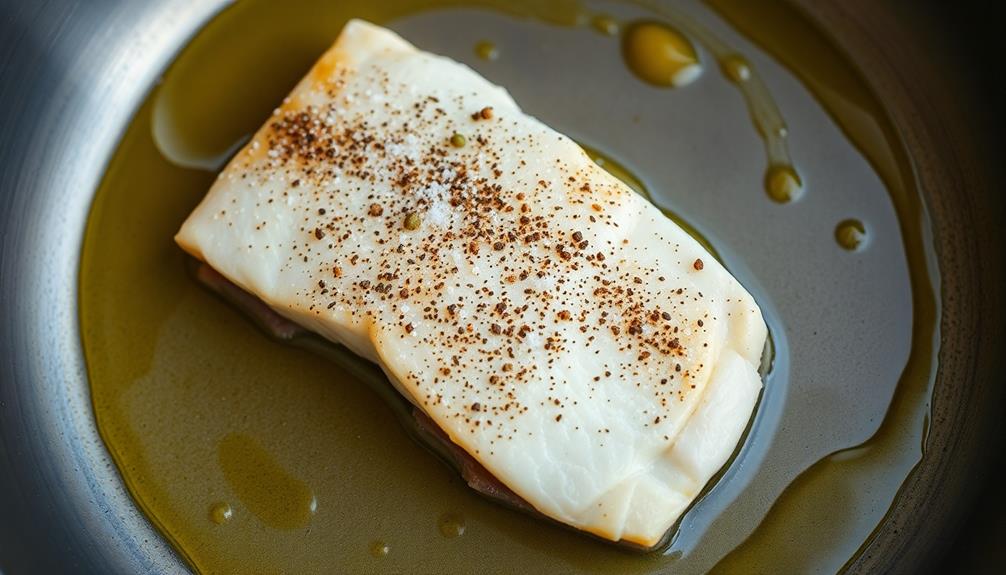
First, liberally season the fish fillets on both sides with salt and freshly ground black pepper. The salt will help enhance the natural flavors of the fish, while the pepper adds a delightful kick of warmth and depth. Gently rub the seasonings into the flesh, ensuring even coverage for maximum taste in every bite.
Next, take a moment to admire the way the seasoning clings to the surface of the fish, creating an appetizing visual contrast. The dark specks of pepper dotting the pale fillets are a tantalizing prelude to the savory, satisfying meal to come.
As you season, imagine the sizzle and aroma that will fill the kitchen once the fish hits the hot pan.
With the fish seasoned to perfection, you're now ready to move on to the next step: browning the butter for the beurre meunière sauce. Get ready to witness the transformation of simple ingredients into a truly remarkable and versatile topping for your delicious seafood dish.
Final Thoughts

Ultimately, the beurre meunière sauce is an elegant and versatile accompaniment that can elevate a variety of fish dishes. Its rich, nutty flavor and velvety texture make it a perfect pair for delicate white fish, while also complementing the heartier taste of salmon or tuna.
The browned butter sauce adds a luxurious dimension, turning a simple pan-seared fillet into a truly impressive meal.
Don't be intimidated by the fancy French name – beurre meunière is surprisingly easy to prepare at home. With just a few pantry staples and a bit of attention, you can create a restaurant-worthy sauce that will have your family and friends thinking you're a culinary pro.
Serve it over your favorite fish, or try it drizzled over roasted vegetables or even spooned over mashed potatoes for a decadent side dish.
Frequently Asked Questions
How Do I Store Leftover Beurre Meunière?
To store leftover beurre meunière, transfer it to an airtight container and refrigerate. It'll keep for up to a week, but you'll need to reheat it gently before using to restore its velvety texture.
What Types of Fish Work Best With Beurre Meunière?
Delicate, mild-flavored fish like sole, tilapia, or halibut work best with beurre meunière. The nuttiness of the browned butter complements the light, flaky texture of these fish, creating a harmonious and flavorful dish.
Can Beurre Meunière Be Made in Advance?
Yes, you can make beurre meunière in advance. The browned butter sauce can be prepared ahead of time and reheated just before serving. This makes it a convenient option for quick and easy meal preparation.
Is Beurre Meunière Gluten-Free?
Yes, beurre meunière is gluten-free. It's a simple sauce made from browned butter, lemon juice, and parsley. Without any flour or other gluten-containing ingredients, it's a safe option for those following a gluten-free diet.
How Long Will Beurre Meunière Keep in the Refrigerator?
Beurre meunière can be stored in the refrigerator for up to a week. It's best to keep it in an airtight container to maintain its flavor and consistency. Enjoy the delicious, nutty sauce whenever you're ready to use it.

